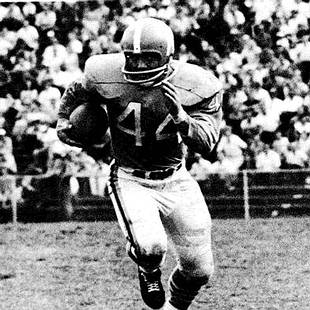

"VISIONS OF SUCCESS"
HELMET NEWS, HELMET REFLECTIONS FOR MAY 2008
By Dr. Ken
As a young adolescent trying to establish myself in the social hierarchy and as an athlete, it was painfully obvious that my talent level and the starting point of my social skills were near the bottom of the barrel. Even in a blue-collar, rough hewn neighborhood, my family’s general philosophy of “when in doubt, knock ‘em out” didn’t go a long way in making friends and positively influencing those around me. My grandfather and father both had “reputations” that covered the gamut of positive to negative. Both were known as “stand-up guys, good guys” but both had what was recognized and accepted as mercurial tempers that could go off of the charts within the blink of an eye and little hesitation to get physical if that seemed like a reasonable way to efficiently determine the end-product of any discussion. Although I lost more fights than I won, I was seen as fitting in well with the established family tradition.
Being quite a bit smaller than most of the males in my class, my grade, and in the school I entered when we moved to a rather isolated small town, the covers of some of the muscle magazines seemed like the means to a necessary end. My father, as old-fashioned as one could get, applied his fifth grade education and very narrow immigrant-influenced view of the world to the matter. This led to the pronouncement that any kind of weight training would “stunt your growth, make you muscle-bound and slow, and probably make you queer”. The latter term, the most often invoked 1950’s New York area expression for an alternative lifestyle, left me rather mystified as even at the age of twelve, I didn’t see the cause and effect, but the myths surrounding weight training that dictated the immediate “binding up” of one’s useable muscles and a total loss of speed and reaction was a rather common belief among athletes and coaches. In spite of a complete lack of support, I forged ahead with a crude and rudimentary weight training program, using the monthly muscle magazines to guide me. Even at the age of twelve, the results were noticeable. Though still small, the work done in the garage and basement heaving and hauling the barbells made from truck axles and flywheels and “dumbbells” fashioned from pails of sand and cement made me strong. Working in my father’s iron and welding shop as a pack mule and indentured servant made me strong, tough, and hostile!
My goal was not to “look good” or “be strong” but to “become a better football player.” For motivation I looked to the pro players brought to me in the magazines and on television and a few propelled me to further heights, at least mentally. The obvious favorite was 5'6", 205 pound Charley Tolar, “The Human Manhole Cover” that played fullback for the Houston Oilers.
 |
I had an immediate affection for the American Football League and the Oilers had a few players I could relate to. Billy Cannon was one of the first successful football players to use weight training and he was featured on the cover of the November 1959 issue of Strength And Health magazine. Running backs Dave Smith and Mike Dukes looked tough and to me, George Blanda was a former NFL “great” although he truly didn’t hit his stride until entering the AFL as an “older” player. It was enough for me however, to share my allegiance between the hometown New York Titans and the Oilers. Tolar however, was far and away the big time influence. He hit his stride in 1962, gaining over 1000 yards, and I tried to chop opponents’ legs out from under them, using my distinct lack of height just as Tolar was doing. At 145 pounds, I was far from a manhole cover but I tried to emulate the style.
The swimming coach at Long Beach High School was Woody Davis whose summer job on the beach allowed me to see him daily. He had graduated as an accomplished athlete from Washington State and was friends with Keith Lincoln who starred for the Chargers. It was amazing to me that I could know someone who actually attended college and was friends with a pro player but I paid special attention to Lincoln. He was, at 6’1” and 215 pounds, not one I could normally relate to as a “short” or “small” player but Mr. Davis’ personal relationship with him and the fact that I was informed that “he lifts weights” was enough to make me envision myself in a Chargers uniform when suiting up for high school practice. Lincoln fell into my “Jon Arnett category”, a bit too large to fully relate to but for other reasons, a player I wanted to be. Lincoln’s performance in the January 5, 1964 AFL Championship game against the Patriots really got my attention. He rushed for a record 206 yards and seemed to be unstoppable.
 |
With visions of perennial favorite Johnny Olszewski and Tolar in my mind, every day on the practice field was a joy. Augmented by a few speed-fueled sweeps by my mental image of “Jaguar Jon” Arnett and an occasional slashing run by Lincoln, I had all of the psychological bases covered. Without knowing it, I was on the cutting edge of what was later called “visualization” although the term and its explanation then would have brought spasms of laughter.
We are all motivated differently but viewing photos, DVD’s, or the written word about Tolar, Johnny O, or the other running backs that supplied that motivation through high school and collegiate football, still produces an excitement and positive burst of energy that was present so many decades ago. Envisioning the great uniforms and helmets of that era does the same, reinforcing the images of toughness and an old fashioned work ethic that still propels me through many days.